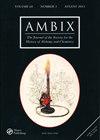看不见的有毒物质。环境无知建设
IF 0.3
3区 哲学
Q3 HISTORY & PHILOSOPHY OF SCIENCE
引用次数: 1
摘要
在工厂工作的专业化学家的教育水平较低,与机械工程操作员处于同等水平。De chemister是Vermande博士论文的出版版本。这有助于解释这样一个事实,即这本书包含了许多小的摘要和重复,以及该类型典型的大量附录。Vermande专注于化学家的职业,而没有太多关注主要来源材料的背景。例如,他经常在17世纪末的小册子中引用化学物质,但他似乎不知道当时小册子战争的背景和修辞,因为它们的语言极其粗糙,并且主要关注(阿姆斯特丹)医疗部门的保密性和自身利益。对这些争议进行更具体的分析本可以加强论文的论点。Vermande的书涵盖了220年的时间,但分析的重点是17世纪末和1760–1820年。十八世纪上半叶仍然没有得到充分的讨论。这是一个遗憾,因为在这一时期,荷兰被称为化学和医学教学的温床,这肯定对化学家的受欢迎程度产生了直接影响。首先,解剖学和解剖学制剂的制作——例如Frederik Ruysch和Bernhard Siegfried Albinus的工作——比以往任何时候都更加依赖化学技术,化学物质(可能在化学商店出售)及其特殊性质从字面上和隐喻上取代了体液和生理过程。同样,Vermande并没有在Herman Boerhaave及其弟子的流行和有影响力的化学教学背景下分析这位化学家的崛起。最近的历史研究表明,Boerhaave甚至比他的前任Franciscus dele BoëSylvius、Johann Conrad Barchusen和Jacob LeMort更将化学提升为一门严肃的学术学科,这一定对化学家的声望和业务产生了积极影响。究竟是谁为学生的实验活动提供了化学物质?在他的讲座中,Boerhaave还将他的“新”化学方法与前任的化学方法区分开来,从而明确区分了化学家的真伪。这种划分在他的门徒的作品中更为强烈,一定与化学人将自己区分为一个职业群体的需求产生了共鸣。尽管存在这些缺点,但Vermande研究的最大优点是他对化学和医学史上被遗忘的化学物质群体的新颖关注。我发现许多有趣的细节让我思考。例如,我对接管已故丈夫商店的化学寡妇的数量感到震惊,而且在1813年,显然有必要为这些寡妇制定具体的规定——例如,规定妇女必须由一名有执照的男性助理协助。也许化学反应比我们想象的更经常是女性的工作。此外,广泛的附录(超过300页!)为有兴趣进一步研究该主题的历史学家提供了丰富的信息。本文章由计算机程序翻译,如有差异,请以英文原文为准。
Tóxicos Invisibles. La construcción de la ignorancia ambiental
trained chemicus from the lower educational level of the professional chemist who worked in factories, at the same level as operators in mechanical engineering. De chemist is the published version of Vermande’s PhD thesis. This helps to explain the fact that the book contains many little summaries and repetitions, as well as extensive appendices typical of that genre. Vermande focuses on the occupation of the chemist, without paying much attention to contextualising the primary source material. For instance, he regularly cites references to chemisten in late seventeenth-century pamphlets, but he seems unaware of the context and rhetoric of the pamphlet wars at the time, with their extremely crude language and a predominant concern with secrecy and self-interest in the (Amsterdam) medical sector. A more contextualised analysis of these controversies could have strengthened the arguments of the thesis. Vermande’s book covers a period of 220 years, but the focus of the analysis is on the late seventeenth century and on the period 1760–1820. The first half of the eighteenth century remains underdiscussed. This is a pity, because during this period the Netherlands were known as a hotbed of chemical and medical teaching, which must have had a direct effect on the popularity of the chemist. For a start, more than ever before, anatomy and the making of anatomical preparations – for instance the work of Frederik Ruysch and Bernhard Siegfried Albinus – heavily relied on chemical techniques, whereby chemicals (presumably sold in chemical shops) and their particular properties literally and metaphorically took the place of bodily fluids and physiological processes. Similarly, Vermande does not analyse the rise of the chemist against the backdrop of the popular and influential chemistry teaching of Herman Boerhaave and his disciples. Recent historical work has shown that Boerhaave, even more than his predecessors Franciscus dele Boë Sylvius, Johann Conrad Barchusen, and Jacob LeMort, elevated chemistry to a serious academic discipline, which must have had a positive effect on the popularity and business of the chemist. Who, after all, supplied the chemicals for the students’ experimental activities? In his lectures, Boerhaave also demarcated his “new” method of chemistry from the chemistry of his predecessors, thereby making a clear distinction between true and false (al)chemists. This demarcation was even stronger in the works of his disciples and must have resonated with the need of the chemisten to distinguish themselves as an occupational group. Despite these shortcomings, the great merit of Vermande’s study is his novel focus on the largely forgotten group of the chemisten in the history of chemistry and medicine. I found many interesting details that set me thinking. For example, I was struck by the number of widows of chemisten who took over the shops of their deceased husbands, and the apparent need, in 1813, to formulate specific regulations for these widows – stating, for example, that the women must be assisted by a licensed male assistant. Perhaps chemistry was a woman’s job more often than we have thought. Moreover, the extensive appendices (over 300 pages!) offer a wealth of information for historians interested in further research on the topic.
求助全文
通过发布文献求助,成功后即可免费获取论文全文。
去求助
来源期刊

Ambix
HISTORY & PHILOSOPHY OF SCIENCE-
CiteScore
0.80
自引率
60.00%
发文量
42
审稿时长
3 months
期刊介绍:
Ambix is an internationally recognised, peer-reviewed quarterly journal devoted to publishing high-quality, original research and book reviews in the intellectual, social and cultural history of alchemy and chemistry. It publishes studies, discussions, and primary sources relevant to the historical experience of all areas related to alchemy and chemistry covering all periods (ancient to modern) and geographical regions. Ambix publishes individual papers, focused thematic sections and larger special issues (either single or double and usually guest-edited). Topics covered by Ambix include, but are not limited to, interactions between alchemy and chemistry and other disciplines; chemical medicine and pharmacy; molecular sciences; practices allied to material, instrumental, institutional and visual cultures; environmental chemistry; the chemical industry; the appearance of alchemy and chemistry within popular culture; biographical and historiographical studies; and the study of issues related to gender, race, and colonial experience within the context of chemistry.
 求助内容:
求助内容: 应助结果提醒方式:
应助结果提醒方式:


